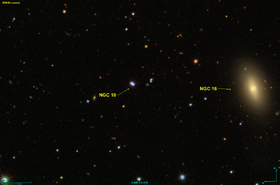Astronomy:NGC 18
From HandWiki
Short description: Double star system in the constellation of Pegasus
| Observation data Equinox J2000.0]] (ICRS) | |
|---|---|
| Constellation | Pegasus[1] |
| Right ascension | 00h 09m 23s[1] |
| Declination | +27° 43′ 56″[1] |
| Apparent magnitude (V) | 14[1] |
| Other designations | |
| Database references | |
| SIMBAD | Pul-3 10207 |
| Pul-3 10208 | |
NGC 18 is a double star system located in the constellation of Pegasus.[1] It was first recorded by Herman Schultz on 15 October 1866. It was looked for but not found by Édouard Stephan on 2 October 1882. It was independently observed by Guillaume Bigourdan in November 1886.[1]
Both stars are 2528±20 light-years away, and based on this distance have a minimum separation of approximately 2,700 astronomical units, an unusually wide separation for a binary system.
See also
- Double star
- Binary star
- List of NGC objects (1–999)
References
- ↑ 1.0 1.1 1.2 1.3 1.4 1.5 Seligman, Courtney (March 2010). "NGC Objects: NGC 1 - 49". Celestial Atlas. http://cseligman.com/text/atlas/ngc0.htm.
- ↑ "Pul-3 10207". SIMBAD. Centre de données astronomiques de Strasbourg. http://simbad.u-strasbg.fr/simbad/sim-basic?Ident=Pul-3+10207.
- ↑ "Pul-3 10208". SIMBAD. Centre de données astronomiques de Strasbourg. http://simbad.u-strasbg.fr/simbad/sim-basic?Ident=Pul-3+10208.
External links
 |


